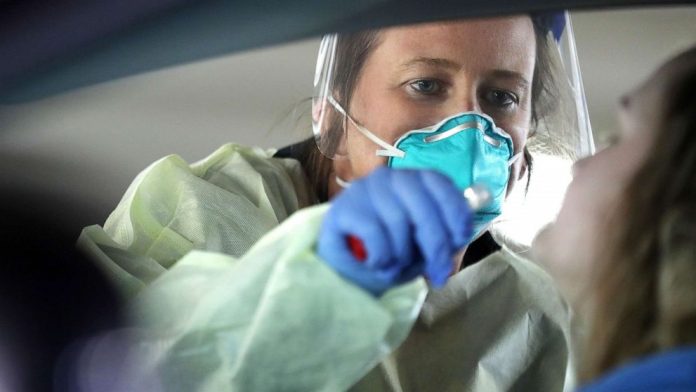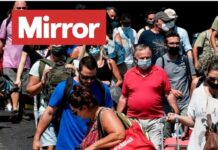Different countries are coming up with different answers to that question. Congratulations world leaders, you’re on the cusp of the once unthinkable — a game-changing coronavirus vaccine developed with record speed. But you have yet to face the truly hard part, at least politically: deciding who gets it.
In theory, everyone in the world who wants it should eventually be able to get immunized. But for much of 2021, demand for the coronavirus vaccine will outstrip supply, presenting a massive dilemma for governments, which must decide who gets the vaccine first or early, and who must wait.
The U.S. federal government’s world-leading “Operation Warp Speed” vaccine program plans to distribute 6.4 million doses of a Pfizer/BioNTech vaccine within 24 hours of regulatory clearance. But even this initial effort to immunize front-line health-care workers risks wasted doses, and that’s just Step 1, in one country.
Many disputes over prioritization will play out in the fine print of government plans. Is a hospital janitor more at risk than a suburban pediatrician? Is a truck driver’s super-spreading danger a greater priority than the risk faced by a 50-year old with diabetes?
“You want to target the highest risk, because this will get you the biggest benefit,” said Tom Kenyon, a former director of CDC’s Center for Global Health, who cited the example of truck drivers in Africa being identified as key spreaders of the virus.
Serious questions also arise around equity. “We will not have succeeded if a healthy 20-year old in New Jersey is getting vaccinated before a frontline health care worker in South Sudan,” said Kate Elder, senior vaccines policy adviser for Doctors Without Borders’ Access Campaign.
With the vaccine likely to be administered outside hospitals in many instances — in pharmacies, from mobile van facilities — verifying that recipients have certain health conditions will rely on either huge databases or an honor system. There’s no easy way for non-specialists to confirm comorbidities instantly.
If past vaccination campaigns are any guide, there’s also a risk of bribery and favoritism: A Canadian health care worker was fired in 2009 for giving famous hockey players early access to the H1N1 vaccine.
Many governments are keeping their options open until final details of vaccine efficacy and delivery timelines are available. According to a POLITICO survey of the approaches of 40 governments, the core elements of most national plans are prioritizing healthcare workers and older populations. Here are the most relevant elements of those plans:
United States
Government officials say it will be April before most people could get vaccinated. A government Advisory Committee on Immunization Practices (ACIP) is prepared to issue its prioritization guidance Dec. 10. But HHS Secretary Alex Azar said this week the federal government won’t wait for ACIP recommendations if a vaccine is authorized before then.
While federal and state officials agree that the nation’s 21 million health care workers should be first in line for the vaccine, there is no consensus about how to balance the needs of other high-risk groups. Azar said this week states will have the “final say” in prioritizing Covid vaccinations, and that the shots will be apportioned according to the size of adult populations. Siding with ACIP, California Gov. Gavin Newsom pledged that hard-hit “Black and brown communities disproportionately are benefited” in California’s prioritization plan.
Moncef Slaoui, the former GlaxoSmithKline executive who leads Operation Warp Speed, said there are no easy choices.
“I don’t expect the states to make uniform decisions,” he told POLITICO. “Some may prefer long-term care facilities or the elderly, while others may prioritize their health care workers. It would be wrong to immunize 18-year-olds first. I hope no one does that. But otherwise it’s shades of gray.”
Canada
Canada is taking into account public opinion preferences in its strategy, which suggests “Canadians prioritize those with underlying medical conditions and the elderly,” and also treating “household contacts of those at high-risk of severe illness and death” as potential priorities. The defense department is buying freezers to “store and transport” Covid-19 vaccines for its “military population.”
European Union
Xavier Bettel, prime minister of Luxembourg, said in an interview that the EU has a difficult starting position when it comes to Covid-19 vaccinations: “There is not one country where over 60 percent of people want to get vaccinated.”
However, a tug-of-war between Brussels-based EU institutions and national governments over how to source and deliver vaccines appears to have ended happily: European Commission President Ursula von der Leyen confirmed this week that the EU has secured vaccines for 430 million people — enough for virtually every EU resident. It would have created a “nightmare” if the EU failed to coordinate distribution, Bettel said.
Among a series of priority measures, the European Centre for Disease Prevention and Control said it will deploy the vaccine to “control active outbreaks.”
Germany’s Standing Committee on Vaccination recommends that prioritization be guided by “urgency of preventive health protection,” aiming to reduce cases most likely to lead to hospitalization or death, and to ensure “maintenance of essential state functions and public life,” which includes police, firefighters and teachers, in addition to healthcare workers.
United Kingdom
The U.K.’s Joint Committee on Vaccination and Immunisation has an 11-step order of priority. After healthcare workers, the priorities are older adults in care homes, then older Britons, starting with the eldest and descending in 5-year age brackets.
Japan
Japan’s top priority is older citizens with chronic conditions. Citizens will be issued coupons indicating their order of priority, Japan’s Health, Labor and Welfare Ministry said.
India
Class and geographic divides have produced significant variations in India’s death rates. 80-year-olds in some states are surviving more often than 60-year-olds in others, University of Chicago Professor Anup Malani writes on behalf of The Indian Covid Alliance. The government’s response: set a lower age threshold than most Western countries — 50 years — for priority access.
The task is massive. There are 260 million Indians aged 50 or older, and around 20 million frontline workers. The government is concerned about confusion over who is entitled to priority access. A National Expert Group on Vaccine Administration has worked with state governments to create a new “digital platform for vaccine administration and distribution” the group said in a statement.
South Korea and Taiwan
As standout performers in controlling Covid-19, the two East Asian nations also share an unusual vaccine deployment approach: They’re relatively relaxed about it. As members of the COVAX facility — which is pooling the resources of 186 governments to accelerate vaccine development and distribution — both governments are prioritizing buying the vaccine at the right price, rather than as soon as possible. Each plans to buy enough vaccines for only around 60 percent of their populations.
While Taiwan has a history of high demand for vaccines — the Taiwan Centers for Disease Control reported an average 98 vaccination rate in 2019 — the government is not afraid to ration vaccines. In November, the government banned people aged 50 to 64 from receiving state-funded influenza vaccines, in order to prioritize more vulnerable groups.
Indonesia
The world’s most populous Muslim nation stands apart for its decision to prioritize young workers aged 18 to 59 for the vaccine, once healthcare workers have been inoculated. Indonesian government ministers told Reuters they expect the country’s independent drugs agency will approve China’s Sinovac and Sinopharm vaccines in the first week of December.
Australia and New Zealand
An Australian government health protection committee provided the Cabinet with an official list of most exposed workers, including those in prisons and group care homes. After that, Australia is likely to prioritize older people, those with preexisting conditions and indigenous Australians, who typically have far worse health outcomes than the population overall, according to the Australian Technical Advisory Group on Immunization.
New Zealand’s model is similar to Australia’s, including close partnerships with its indigenous Maori communities. The government said its vaccine prioritization will be guided by WHO advice and says it has an “obligation” to ensure equitable distribution of the vaccine among neighboring Pacific Island nations.
Ecuador
After seeing at least one of its cities overwhelmed with the number of deaths caused by the virus earlier this year, Ecuador will focus on first responders. The government’s vaccination plan — which WHO boss Tedros Adhanom Ghebreyesus praised in a press conference this week — includes priority for firefighters, trash collectors and people working in the food chain as well as healthcare workers, according to a local media report. / Politico














